
Have you ever wondered what goes on in that little patch of bottomland woods you pass by everyday on your drive to work? You know the woods I’m talking about… we have them all around the metroplex. These dense and tangled forests can be seen anywhere our highways approach the mighty Trinity and its tributaries. Can you drive by these types of places and not be tempted to imagine about the wildlife within?
Me? I can’t help but be curious. Every grove of trees, every open meadow, every boggy marsh sets the wheels to turning in my head. For some reason, I just want to know about what’s going on in there.
This past February, I found one such place along the Trinity River that really appealed to me. Public land, for sure, but far enough off the beaten path that it would be rarely–if ever–disturbed by people. This would be a great place for a trail camera survey to reveal more about the wildlife that lives along our urban stretches of Trinity River bottoms.
The hike to my destination was fun in and of itself. There was plenty of wildlife and scenery to observe along the way. I took a few pictures to document the trek as I worked my way ever closer to the predominant Trinity.


the habitat provided by the man-made borrow pit



Plastic in their scat tells the tale

When a group like this dives in unison, it’s a clear indication
you are observing goldeneyes

A Deep Winter Window into the Bottomlands
Approaching the forest, I pushed my way past barriers of dense Cedar Elm, Chinese Privet, and tangled Greenbriar vines. Eventually, I came to this little glade lost in the middle of it all. This spot intrigued me for a couple of reasons. Shallow pools collected here under the canopy, creating an expansive network of water throughout this region of the forest. This spot was not quite a marsh, but not quite a normal woodland either. I couldn’t help but wonder how the area wildlife adapted.
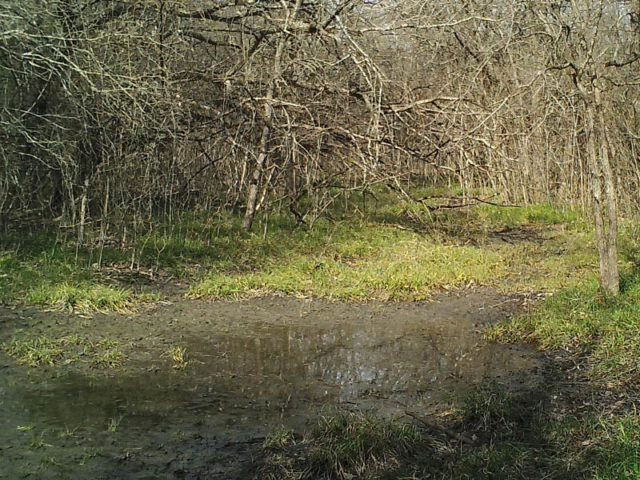
And there was certainly plenty of wildlife to be found here. Animal tracks were everywhere. Prints left by deer, Coyotes, Bobcats, and others littered the ground. This was definitely a busy place.
I also noticed a couple of well worn small-animal runs criss-crossing the clearing. They emerged from and disappeared into low growth underbrush, suggesting that what ever made and used these paths traveled close to the ground. The trails were so heavily used that the earth was bare and the soil was compacted–so much so that individual paw prints no longer registered in the dirt.
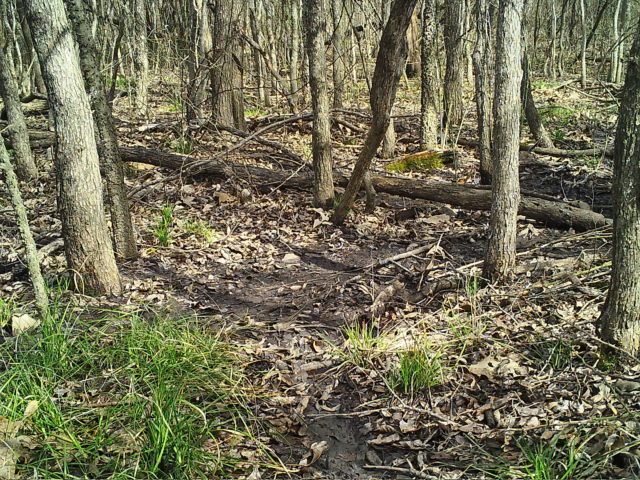
I have seen game trails like these before, and I have always wondered which of our small mammals were responsible for making them. We have several candidate critters here in North Texas–Opossums, Armadillos, Striped Skunks, and Raccoons to name a few. This little glade seemed to be a good place to try and gain some real insight.
I set my cameras in various places in this part of the bottoms, and left them to run for the long term. My plan was to come back in a few months, quickly review the pictures that were recorded, and–if the photos were compelling–reset the cameras so they could continue the survey through the summer.
When I returned in mid-April, I found that the cameras had recorded hundreds of pictures. Together they painted an interesting picture of wildlife in the bottoms. I replaced the SD cards and batteries, and left the cameras behind to continue recording pictures through the spring and summer. I took the SD cards holding the collection of deep winter pictures home with me for further review.
First, there is the matter of the small game trails that crisscrossed the glade… While it is obvious from these pictures that many different kinds of forest creatures use these trails, the evidence would suggest that they likely originally established by Raccoons.
Raccoons are creatures of habit–these pictures certainly prove that out. The masked rascals spend much of the day dozing in their favorite tree just waiting for night to fall. Under the cover of darkness they come down from the branches and travel one of their well-worn trails to a preferred foraging ground. It’s like clockwork–the same Raccoons show up on the same camera, at the same time, night after night.

It quickly became obvious that Raccoons are the masters of this part of the forest–much as they are in the majority of habitats all across Dallas/Fort Worth. Clever, dexterous, and resourceful, Raccoons excel at the art of survival. They were by far and away the most commonly photographed critter during this survey. The sheer number of Raccoons living in the metroplex never ceases to amaze me.

in water, in total darkness. Their night vision must be remarkable!
There were plenty of others animals sharing the forest–all the usual suspects were present and accounted for. I took a little time to total up the numbers and compile some statistics. When considered in its entirety, I was a little surprised by the mix of wildlife in this urban wilderness oasis–in terms of percentages. Perhaps you will be too. Here’s the breakdown…
| Animal | Number of Pictures | Percentage |
| Common Raccoon | 190 | 49% |
| White-tailed Deer | 129 | 35% |
| Eastern Cottontail | 17 | 4% |
| Coyote | 16 | 4% |
| Bobcat | 10 | 3% |
| Virginia Opossum | 9 | 2% |
| Various Songbirds | 5 | 1% |
| Eastern Screech Owl | 4 | 1% |
| Fox Squirrel | 2 | 0.5% |
| Nine-banded Armadillo | 2 | 0.5% |
As you can see, after Raccoons it was White-tailed Deer that were the second most photographed animal in this survey. We have a surprising number of White-tailed Deer living with us here in urbanized DFW. Our largely interconnected network of creeks and rivers create riparian corridors that allow White-tailed Deer to roam into all corners of the metroplex. I have been surprised by some of the unexpected places they have made appearances.
Despite their relatively large size and general abundance, deer in Dallas/Fort Worth go unseen by most. They seem to be doing a pretty good job of limiting their activities to times and places where people are not around. I’m also not aware of many reports of collisions with automobiles, as can occur frequently in areas with lots of White-tailed Deer. Let’s hope that is reflective of the actual situation, and that it is a trend that continues!
One thing you can be certain of as you drive by those dense bottomland woods on your way home every day, is that there may very well be a deer or two looking back at you from the cover of the forest.
In addition to the deer, we also found a hodge-podge of other critters passing through this glade with some regularity. Coyotes and Bobcats patrolled routinely. Opossums gladly followed the trails laid down by the intrepid Raccoons. And the pools of water even attracted the occasional wading bird in the form of an egret or heron. This place in the woods was remarkably busy all season long–wet or dry.

In the first image an Eastern Screech Owl flies by and triggers the camera.
A few minutes later, a Raccoon triggers a second camera just around the corner from
the first, inadvertently revealing where the Screech Owl had landed
So, now you know what lives in those woods that border your morning commute. There’s a lot going on behind all those trees. I recently returned to this location and collected the next set of pictures. I’m very eager to see how the dynamics in the bottomlands changed with the heat of the summer. Maybe there be some baby critters as we move deeper into the warm months. I’m looking forward to sharing those pictures here with you soon!



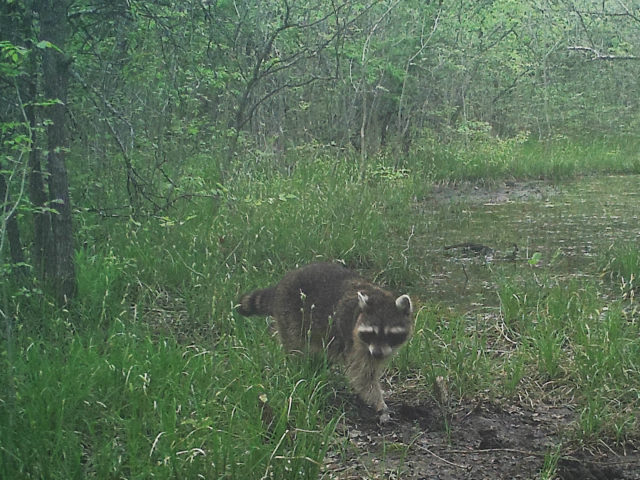










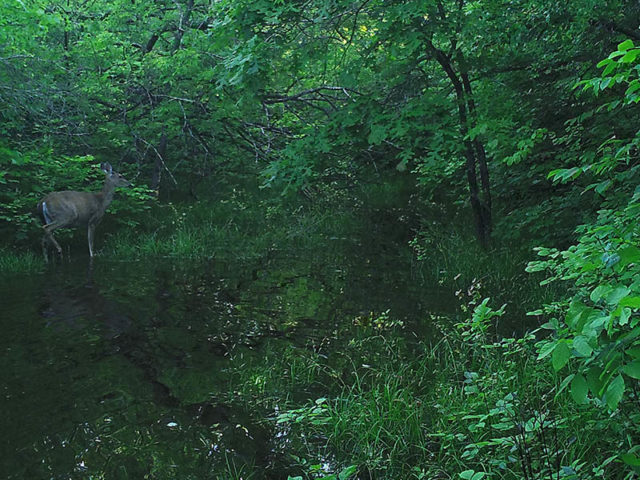
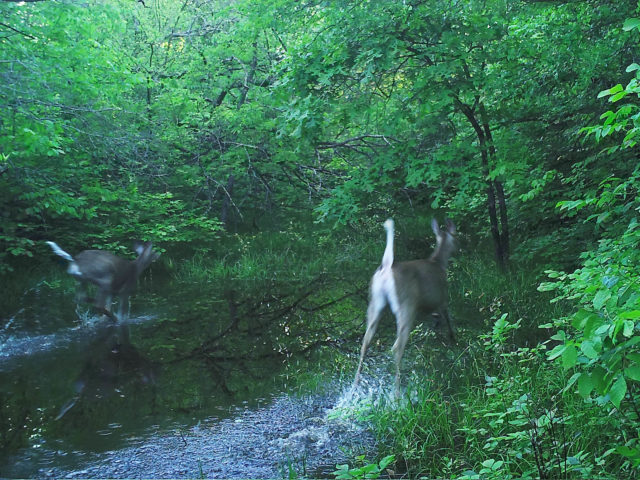






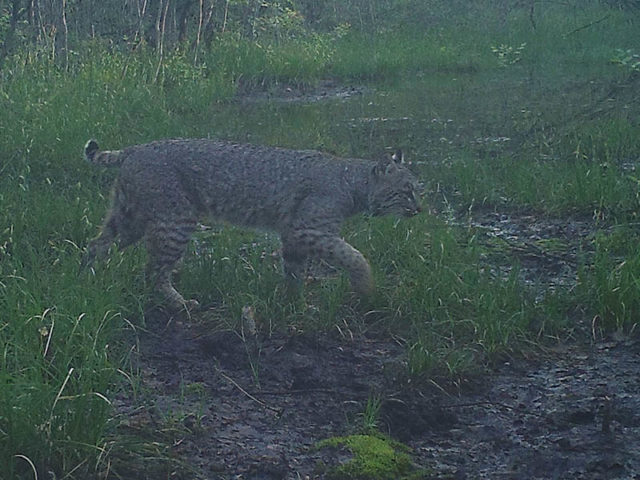






So much fun to read. Thank you!
Fascinating! Thanks for enlightening us.
I am recovering from a knee revision and looking at these pics takes me to a happy place. I hope to get back outside by Christmas.
Feel better, Gloria!
Thoroughly enjoyed the read : ) how is the amphibian/reptile wildlife in these areas?
Hey Chris it was great reading this article and your efforts to make this article happen for us, I am wondering if you ever surprised your self with wild animals around or you fairly aware about the areas you explore.
Thanks
Ketan
There are always some surprises, no matter how familiar with an area I get!